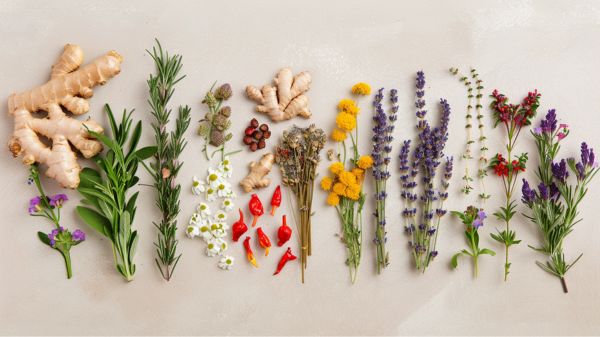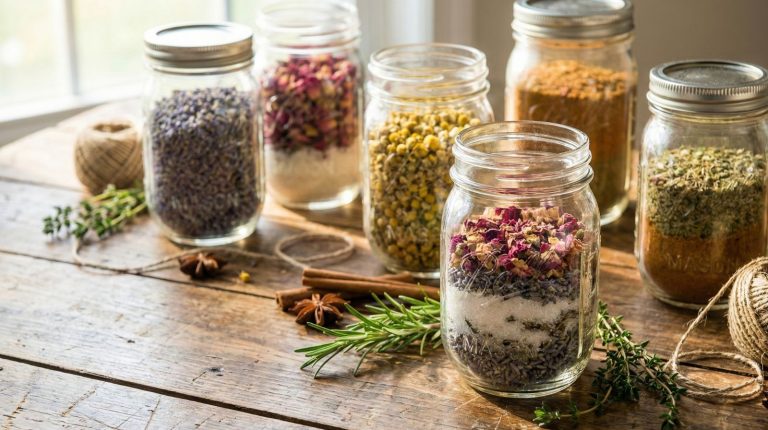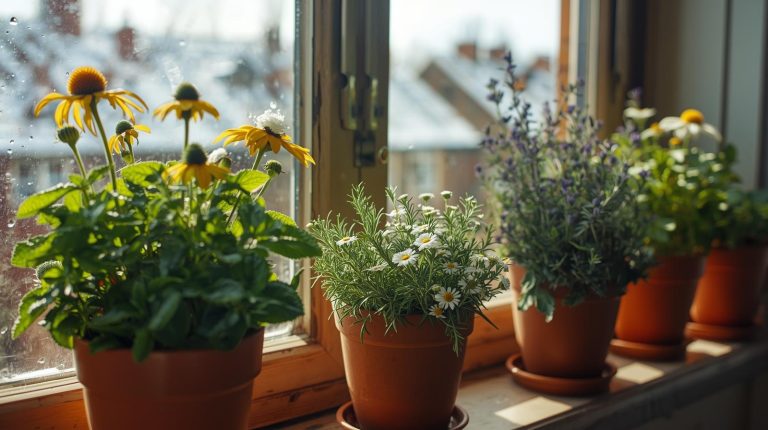Identifying medicinal herbs in the wild is a practice that offers numerous advantages, from accessing potent health benefits to fostering a deeper connection with the natural world. In this article, we’ll be discussing why and how to identify medicinal herbs in the wild.
Wild herbs often contain higher concentrations of active compounds, potentially leading to more effective therapeutic outcomes compared to their cultivated counterparts. Additionally, sustainable foraging practices can support environmental conservation while providing cost-effective healthcare alternatives.
Understanding the intricacies of safe harvesting and recognizing nonnative plants further enriches one’s knowledge in herbalism. How do these aspects intersect to create a holistic approach to wellness, and what essential steps should be taken to guarantee responsible foraging?
Key Takeaways
- Wild herbs have higher concentrations of active constituents, enhancing their therapeutic effects.
- Foraging medicinal herbs connects individuals to nature and traditional knowledge.
- Identifying herbs empowers individuals with valuable herbalism skills.
- Wild herbs offer higher concentrations of essential nutrients and antioxidants.
- Sustainable foraging practices promote ecological health and biodiversity conservation.
Health Benefits
The health benefits of identifying medicinal herbs in the wild are multifaceted, encompassing enhanced access to potent natural remedies, increased concentrations of beneficial compounds, and the promotion of sustainable, holistic healthcare practices.
Wild herbs, often growing in their natural habitats, tend to exhibit superior concentrations of active constituents compared to their cultivated counterparts. This higher potency can amplify their therapeutic effects, offering robust solutions for various health ailments.
Furthermore, the practice of foraging and identifying wild medicinal herbs fosters a profound connection to nature, encouraging individuals to engage with their environment in meaningful ways. This connection is not merely physical but also cultural, as it revives traditional knowledge and practices that have been passed down through generations.
Understanding the botanical characteristics and medicinal properties of wild plants enables individuals to address health concerns more holistically and affordably, bypassing the often prohibitive cost of pharmaceutical treatments.
In addition, the process of learning to identify these herbs equips individuals with valuable skills in herbalism and botany, empowering them to take control of their health. This empowerment aligns with a broader movement toward self-sufficiency and liberation from dependency on industrial healthcare systems.
Sustainable Foraging
Sustainable foraging is integral to preserving wild medicinal herb populations, necessitating careful selection of abundant species and avoidance of rare ones. By consulting reputable resources such as United Plant Savers, foragers can gain insights into proper identification and sustainable harvesting techniques.
Evaluating the local population dynamics and potential environmental pressures on these plants guarantees that foraging practices remain ecologically responsible.
Abundant Plant Selection
Selecting plants with large, widespread populations is essential for sustainable foraging to prevent ecological imbalance and secure long-term availability of medicinal herbs. The practice of foraging for wild medicinal plants demands a keen awareness of the ecosystem, emphasizing the importance of abundant plant selection. This methodology is not only necessary to safeguard the environment but also to guarantee the continuous availability of these essential resources.
United Plant Savers, an organization dedicated to the conservation of native medicinal plants, provides invaluable guidance on sustainable foraging. By following their recommendations, foragers can make informed decisions that support ecological balance.
Here are key steps to bear in mind:
- Identify Abundant Species: Focus on plants that are plentiful and widely distributed to minimize ecological impact.
- Monitor Population Health: Consistently assess the health and quantity of plant populations to avoid overharvesting.
- Adopt Rotational Harvesting: Rotate foraging areas to allow plant populations to recover and thrive.
- Educate and Advocate: Spread awareness about sustainable foraging practices and the importance of preserving wild plant populations.
Avoid Rare Species
In addition to selecting abundant species, avoiding scarce species is a fundamental aspect of sustainable foraging practices to guarantee the preservation of vulnerable plant populations. Scarce species often face higher risks of overharvesting, which can lead to substantial declines or even extinction. Sustainable foraging, hence, necessitates a keen understanding of plant populations and their ecological pressures.
By focusing foraging efforts on abundant medicinal herbs, foragers play an active role in preserving scarce species. This approach not only aids in maintaining biodiversity but also secures that future generations can benefit from these natural resources. Utilizing resources like United Plant Savers can provide valuable guidance on identifying and protecting scarce and endangered plant species, further supporting sustainable foraging efforts.
Detailed observations and informed decisions become essential in distinguishing between abundant and scarce species. For example, recognizing the ecological roles and population dynamics of different plants allows for more responsible harvesting practices. By prioritizing the conservation of scarce species, foragers embody a commitment to ecological stewardship and cultural continuity, fostering a harmonious relationship with the natural world.
Ultimately, sustainable foraging practices that avoid scarce species contribute significantly to the long-term health and resilience of wild plant populations, promoting both environmental integrity and cultural liberation.
Population Assessment
Evaluating the population size and distribution of medicinal herbs in their natural habitats is important for maintaining ethical and sustainable foraging practices. Understanding plant population dynamics is vital to preventing the depletion of valuable species and maintaining ecological balance.
Sustainable foraging hinges on the careful assessment of herb abundance and the pressures these plants face in their ecosystems. To foster sustainable foraging, consider the following guidelines:
- Assess Plant Abundance: Prioritize harvesting plants that have strong and widespread populations. This helps to safeguard their survival from threats posed by foraging activities.
- Monitor Ecological Impact: Regularly evaluate the impact of foraging on the local ecosystem. Be aware of overharvesting, even if the plant population appears plentiful.
- Consult Expert Resources: Seek guidance from organizations like United Plant Savers to make informed decisions about which plants can be ethically foraged.
- Promote Long-term Health: Focus on foraging practices that support the long-term health of ecosystems, ensuring that both medicinal herbs and their surrounding habitats thrive.
Nonnative Plants
Nonnative plants, such as multiflora rose, Japanese honeysuckle, and burdock, offer a unique opportunity for foragers to access nutrient-dense and antioxidant-rich resources in human-altered landscapes. These wild plants thrive in spaces altered by human activity, often creating a bountiful supply of medicinal and edible resources that would otherwise go unnoticed.
By recognizing and utilizing these plant species, foragers can enhance their access to concentrated nutrients and antioxidants, contributing to a more sustainable and self-sufficient lifestyle.
Cultivating nonnative plants and wild weeds in home gardens further diversifies the array of medicinal and food sources available. This practice not only echoes the sustainable traditions of our ancestors but also maximizes the yield of edible and medicinal plants within urban and suburban environments. Foragers who seek liberation from conventional food systems will find value in the abundance these plant species offer.
Observing the growth patterns and seasonal availability of nonnative plants can lead to a deeper understanding of their benefits and applications. Incorporating nonnative plants into daily life allows for a more resilient and adaptive approach to foraging, transforming overlooked spaces into thriving sources of wellness and sustenance.
Safe Harvesting
Safe harvesting practices are essential for guaranteeing the long-term sustainability and health of wild medicinal plant populations. To achieve this, one must adhere to principles that not only protect the environment but also provide personal safety and legal compliance.
Proper identification is the cornerstone of safe harvesting practices. Misidentifying plants can lead to the accidental ingestion of toxic species, posing significant health risks. Accurate identification can be achieved through thorough research and consultation of reliable resources.
To practice safe harvesting, consider the following guidelines:
- Maintain Distance from Roads: Harvest plants at least 30 feet away from roads to minimize exposure to pollutants and contaminants.
- Consult Resources: Utilize organizations like United Plant Savers for detailed guidelines on sustainable harvesting techniques.
- Obtain Permission: Always seek permission before harvesting on private or governmental property to adhere to legal requirements and respect land ownership.
- Sustainability: Avoid over-harvesting by taking only what is needed and making sure that plant populations are left intact to regenerate.
These practices empower individuals to safely and sustainably harvest medicinal herbs, fostering a deeper connection with nature and promoting ecological balance. Safe harvesting practices are not just beneficial; they are crucial to preserve the delicate harmony of our natural world.
Nutritional Value
Incorporating wild medicinal herbs into one’s diet can greatly enhance nutritional intake due to their higher concentrations of essential vitamins, minerals, and antioxidants compared to cultivated plants.
These wild foods offer a natural and unprocessed source of bioavailable nutrients, supporting various bodily functions and promoting overall health. Foraging for wild medicinal herbs provides access to a diverse range of nutrients that are often diminished in commercially grown counterparts, making them a potent addition to any diet.
The nutritional richness of wild herbs is not just limited to their vitamin and mineral content. Many of these plants are also packed with unique and potent compounds that have been shown to support immune function, reduce inflammation, and improve overall well-being. For instance, herbs like nettle and dandelion are renowned for their high iron and calcium content, while elderberry and rosehip are celebrated for their powerful antioxidant properties.
Educational Resources
Educational resources are paramount for accurately identifying medicinal herbs in the wild. Online foraging courses, herb identification guides, and field tutorials provide in-depth knowledge and practical experience.
These resources offer detailed insights into plant morphology, botanical characteristics, and safety protocols. They enable foragers to distinguish between similar species and understand ecological contexts.
Access to such educational tools is critical for ensuring both the efficacy and safety of foraging practices.
Online Foraging Courses
Online foraging courses, such as those provided by the Chestnut School of Herbal Medicine, deliver an extensive curriculum encompassing the safety, ethics, botany, and identification of wild medicinal herbs.
These programs cater to individuals seeking profound liberation through a reconnection with nature and self-sustenance. By honing skills in plant identification, participants gain a deeper understanding of the flora around them.
These courses offer a plethora of resources, including:
- Comprehensive Tutorials: Detailed lessons on identifying various medicinal herbs, ensuring accuracy in distinguishing beneficial plants from potentially harmful ones.
- Field Guides: Practical guides that support learners in real-world applications, enhancing their ability to forage safely and sustainably.
- Ethical Foraging Practices: Emphasis on responsible harvesting techniques that preserve natural ecosystems and promote biodiversity.
- Botanical Knowledge: In-depth exploration of plant biology and ecology, fostering a respect for the intricate relationships within natural habitats.
The cultural relevance of online foraging courses cannot be overstated. They empower individuals to reclaim ancestral knowledge and promote sustainable living practices. With scientific accuracy and detailed observations, these courses bridge the gap between modern education and traditional wisdom, offering a path to holistic well-being and environmental stewardship.
Herb Identification Guides
Herb identification guides are essential resources that provide detailed botanical illustrations, photographs, and thorough descriptions to facilitate accurate and safe identification of medicinal plants in their natural habitats.
These guides are indispensable tools for both novices and seasoned foragers seeking to explore the world of medicinal plants and wild edibles. They offer precise visual aids and descriptive texts that assist users in distinguishing between similar-looking plants, ensuring accurate identification—a critical factor for safe and effective foraging.
The in-depth information within these guides extends beyond mere identification. They elucidate the specific plant parts utilized for medicinal purposes, various preparation methods, and potential side effects, thereby empowering individuals to make informed and responsible choices.
This scientific rigor is complemented by an appreciation for cultural practices, reflecting a respect for traditional knowledge systems that have long recognized the value of these wild edibles.
Field Tutorials Available
Field tutorials offer an invaluable opportunity for individuals to gain hands-on experience in identifying medicinal herbs in their natural habitats under the guidance of seasoned experts. These immersive experiences are essential for those seeking to distinguish between various plant species and understand their medicinal properties with scientific precision.
Participants in these tutorials not only acquire practical skills in plant identification but also learn the fundamental principles of foraging ethics and sustainable harvesting practices. The following aspects highlight the core benefits of engaging in field tutorials:
- Practical Identification Skills: Participants learn to recognize key features of medicinal herbs, which is fundamental for accurate identification and avoiding look-alike plants.
- Foraging Ethics: Field experts emphasize the importance of ethical foraging practices to guarantee the sustainability and protection of wild food resources.
- Sustainable Harvesting: Tutorials teach methods that promote the long-term health of plant populations, making certain that they remain available for future generations.
- Enhanced Confidence and Connection: Hands-on experience in natural settings boosts participants’ confidence in wild plant identification and fosters a deeper, culturally relevant connection to nature.
Engaging in these field tutorials empowers individuals with the knowledge and skills necessary to responsibly forage for wild food and medicinal plants, promoting both personal liberation and environmental stewardship.
Conclusion
Identifying medicinal herbs in the wild presents numerous advantages, including enhanced health benefits due to higher concentrations of active compounds, sustainable foraging practices, and the ability to manage nonnative plant species.
Proper identification and safe harvesting techniques guarantee the preservation of natural habitats while providing nutritionally rich and affordable health solutions.
Access to educational resources supports the accurate knowledge transfer, promoting a deeper connection to traditional herbalism and fostering environmentally conscious well-being practices.




